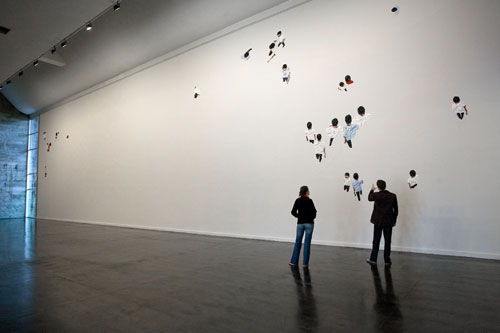MAM – Museu de Arte Moderna do Rio de Janeiro, June 17 – August 3

 |
 |
portuguese | german
Clemens Krauss, Aufwand/Display
"Aufwand/Display" will be the most comprehensive ephemeral interior project of Clemens Krauss to date. Within a time of approximately 4 weeks, he will realize a wall painting project directly on a surface of 800 x 3000 cm in the Museu de Arte Moderna do Rio de Janeiro.
"Aufwand/Display" will only exist for the duration of the exhibition and it is this temporary nature of the elaborate mural that is essential to the project. The display of the artwork followed by its complexity and presentation is compounded by the production and function of the artwork itself, all of which will then be involved in a mutual discourse.
The project "Aufwand/Display" is not only an extensive temporary installation in the museum space, but also a critical analysis of this complex painting, qualified by its protagonists, the different contexts and the work itself developing day by day. Together, all these elements will form the content of the work "Aufwand/Display".
There is an asymmetrical constellation that takes place when an international artist like Clemens Krauss creates a work involving so many specific sources. The artist was invited to do this work by the Museo de Arte Moderna do Rio de Janiero, a public institution in Latin America. The asymmetrical nature of the work emerges as the project expresses, in a metaphorical way, the social injustice with its "wasteful" use of both scale and material. At the same time, "Aufwand/Display" refuses to stress both the moral gesture and the affirmation of social and political facts.
"Aufwand/Display" has the function of activating an intellectual argument with those preconditions and of becoming a platform for the social and political display of the general zeitgeist. Instead of the subjective interest of the individual, this project emphasizes a simple physicality - the reduced scale of the body as a symbol of disintegration compared to the vast scale of Brazil due to the demographically unequal disposition of its population. This idea is represented in the wall painting, which intentionally occupies 2/3 of the whole surface.
The painting belongs to the series "Das Körperkörper-Problem", which represents, through the depiction of the human being, assumed poses that are drawn from the social backdrop of the metropolis and current phenomena such as tolerance and ignorance, fanaticism, oppression and violence. Human mimicry, movements and poses in a political, social or historical context characterise Clemens Krauss' pictorial, photographic and performative work and are key inspirations for this representation.
Krauss himself reenacts and simulates attitudes and characteristics that are appropriated from the everyday media. He assumes postures taken from the omnipresent medial picturepool, e.g. images and reports from the Middle East or violence in global megacities. As a result, isolated bodies find themselves being newly arranged and segregated on a neutral background. In terms of interaction and communication, these single painted bodies therby achieve a reflected ambiguity: loneliness and togetherness, aggression and defence, intimacy, affection, status and power become important themes within the interaction created by the artist. The people or "bodies" extracted from the media that inspire Clemens Krauss’ painting remain anonymous and fragmented. In the end, it is difficult to identify and connect them to the original context from which they were drawn. These almost abstract creatures keep their identity through the relief created by the excess of the applied material.
The complex wall project, although well elaborated and executed, will persist only for the duration of the exhibition "Aufwand/Display", before being destroyed during the de-installation of the work. Within a commercial context, this ephemeral act refers to the current situation of the artwork and the market, analysing the conditions of availability and venality.
In terms of the museological context, the ephemeral nature of the installation refers to the reality of the institution as a place for controversial discourse. Nowadays however, museums find themselves extremely unsupported by public funds so that they have no budget to increase their collection appropriately. Simultaneously, they defend an important position by stipulating the importance of the artworks which is reflected in their value within the market. Ironically, the same museums that impose the importance of the artwork cannot afford to acquire the works for their own collection, but only have a temporary relationship to them. As a result, these institutions become dependent on an interaction with private collectors and sponsors, who improve the value of their personal collections by lending pieces to museums or by purchasing works of artists who are already presented by the institutions.
The work of "Aufwand/Display" exists exclusively for the duration of the exhibition and thanks to this pre-defined period of existence, the work may celebrate its existence without having the possibility to get into a contextualized problematic as mentioned above. It comes, exists for a short time, and then it disappears into the space.
After the projects "Aufgang" at Haus am Waldsee Berlin 2006, "Untitled" at Heidelberger Kunstverein 2007 and "21+4 Bodies" at Stedelijk Museum voor Actuele Kunst Ghent 2007, "Aufwand/Display" at Museum of Modern Art in Rio de Janeiro will be the fourth temporary project of Clemens Krauss in a relevant international institution.
Tereza de Arruda, curator, Berlin, May 2008
Clemens Krauss CV [pdf]
MAM – Museu de Arte Moderna do Rio de Janeiro
[visit website]
Exhibition period: June 17 - August 3, 2008
